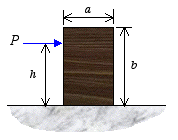Solution:
Part a: We begin by first calculating the maximum friction force that can occur at the contact surface.

Therefore, for the block to be on the verge of sliding, we must have

Next we check to see if there is a chance that the block may tip over under this loading condition. For that we determine the maximum height as

Since h<hmax, there is no chance for tipping to occur. Hence, a force of 62.5 lb will put the block on the verge of sliding.
Part b: To begin the block moving, a force slightly over 62.5 lb is needed. However, once the block begins to slide, the friction force drops to that defined by the coefficient of kinetic friction. That is

Therefore, a force of 50 lb is what is required to keep the block moving at zero acceleration or constant speed once motion is initiated.
